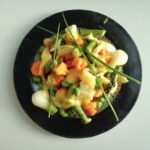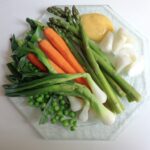 A swirl of lightened mayo over gently steamed carrots, asparagus, peas, spring onions and turnips creates a thoroughly modern version of a very traditional French dish — macédoine. In this update, the veggies may be served either chopped or whole, with homemade mayonnaise on top, on the side or as a sauce. Add some fresh herbs for garnish, and you have a flavor-packed starter, salad or side dish that highlights the beauty of spring.
A swirl of lightened mayo over gently steamed carrots, asparagus, peas, spring onions and turnips creates a thoroughly modern version of a very traditional French dish — macédoine. In this update, the veggies may be served either chopped or whole, with homemade mayonnaise on top, on the side or as a sauce. Add some fresh herbs for garnish, and you have a flavor-packed starter, salad or side dish that highlights the beauty of spring.
Macédoine de légumes / Spring vegetables with mayonnaise
It’s been decades since I’ve seen macédoine on a Paris restaurant menu, probably because it was seriously in need of revision. Although it was once seen as a supremely elegant dish, by the time I arrived in France nearly 50 years ago it had taken a turn towards the stodgy. Macédoine then consisted of overcooked diced veggies slathered in thick mayonnaise, often served stuffed in a tomato or rolled in a slice of ham. But tastes have evolved…
 So I have taken liberties with the traditional recipe, which typically combined diced carrots, green beans, turnips, peas and flageolets, or small, pale green, kidney-shaped beans that are popular in France but may be hard to find elsewhere. This version dispenses with the beans in favor of asparagus and spring onions, which are bountiful in farmers markets here at the moment.
So I have taken liberties with the traditional recipe, which typically combined diced carrots, green beans, turnips, peas and flageolets, or small, pale green, kidney-shaped beans that are popular in France but may be hard to find elsewhere. This version dispenses with the beans in favor of asparagus and spring onions, which are bountiful in farmers markets here at the moment.
 It may be argued that serving the veggies whole, as shown just above, is too much of a stretch, given the origins of the dish. Amusingly, macédoine takes its name from the multiethnic Balkan region of Macedonia. The multicolored chopped vegetables were seen as resembling ethnographic maps of Macedonia in previous centuries, such as the one at left.
It may be argued that serving the veggies whole, as shown just above, is too much of a stretch, given the origins of the dish. Amusingly, macédoine takes its name from the multiethnic Balkan region of Macedonia. The multicolored chopped vegetables were seen as resembling ethnographic maps of Macedonia in previous centuries, such as the one at left.
Just as amusingly, macédoine is also known as salade russe (Russian salad) in France, Italy, Serbia and Bulgaria, while it is known as salade française (French salad) in the Balkans and salade orientale (Middle Eastern salad) in Romania and Moldova. Meanwhile salade russe is known in Russia and elsewhere as salat Olivier, after Lucien Olivier, the Franco-Belgian chef who created it in Moscow in the mid-18oos. His creation was derived from a similar dish, salat stolichny, or ‘capital city salad’, with sour cream instead of mayo. The Russian salads generally include potatoes, and sometimes chicken or seafood.
Getting back to French traditions, it should be noted that there is also a fruit version of macédoine, with chopped bits of apples, cherries, pineapple, strawberries, kiwi, whatever, typically served in a sugar syrup. It is generally quite bland, which is most likely why it, too, has disappeared from bistro menus.
 As for the veggie version, macédoine-style chopped vegetables may also be served warm with butter or cold in aspic, according to the Larousse Gastronomique. But personally I think the mayo version is by far the tastiest. If you’d like to go traditional, you can served your modernized macédoine bathed in homemade mayonnaise lightened with lemon juice, as shown at right. Or you can decompose and recompose as you prefer.
As for the veggie version, macédoine-style chopped vegetables may also be served warm with butter or cold in aspic, according to the Larousse Gastronomique. But personally I think the mayo version is by far the tastiest. If you’d like to go traditional, you can served your modernized macédoine bathed in homemade mayonnaise lightened with lemon juice, as shown at right. Or you can decompose and recompose as you prefer.
Happy cooking.





Il y a salade polonaise comme Macédoine de légumes très populaire en Pologne: https://jadorelyon.com/the-polish-meals-i-miss-the-most-abroad/
Ça appelle salatka warwywna.
Agniesska, many thanks for this interesting comment. Here’s a translation for non-French-speaking readers: ‘There’s a very popular Polish salad like macédoine de légume. It’s called salatka warwywna.’ I checked out the link, which by the way has quite a few tasty looking recipes on it. I guess the main difference from the French version of macédoine is that the Polish version includes pickles and hard-boiled egg. I may just try that one day!
Always nice to see my plates published!
Yes, and aren’t they beautiful!